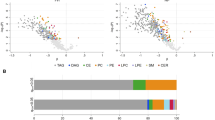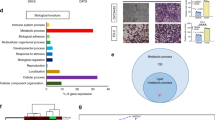Abstract
Despite huge advances in the research of epithelial ovarian cancer (EOC), it remains the most lethal gynecological malignancy. Peritoneal tumor cell dissemination with cell survival and drug-resistance to taxane and platinum-based chemotherapy are two of the major challenges of EOC treatment. We have generated highly aggressive EOC cell lines (ID8-P1 lines or P1) from ID8-P0 (without in vivo passage, or P0) through in vivo passage in mice. We conducted lipidomic analyses in cells from ID8-P0 versus three ID8-P1 cell lines using ultra-high-performance liquid chromatography coupled to electrospray ionization tandem mass spectrometry. A total of 16 classes of lipids (149 individual lipids) were analyzed and compared between P0 and P1 cells. In addition to overall lipid profiles in EOC cells, we had several novel observations. Several classes and species of lipids have been identified to be differentially present in P0 versus P1 cells, which are potentially involved in the acquired aggressiveness of P1 cells. Triacylglycerols (TAG) were dramatically increased under detachment stress in EOC cells. Since survival of EOC cells under detachment is one of the major obstacles for EOC treatment, further studies identifying the molecular mechanisms controlling TAG increase may lead to new treatment modalities for EOC.



Similar content being viewed by others
Abbreviations
- CB:
-
Cerebroside
- Cer:
-
Ceramide
- CH3CN:
-
Acetonitrile
- CHCl3 :
-
Chloroform
- EOC:
-
Epithelial ovarian cancer
- ESI-MS:
-
Electrospray ionization-mass spectrometry
- IPA:
-
Isopropanol
- lysoPtdOH:
-
Lysophosphatidic acid
- lysoPtdCho:
-
Lysophosphatidylcholine
- lysoPtdEtn:
-
Lysophosphatidylethanolamine
- lysoPtdGro:
-
Lysophosphatidylglycerol
- lysoPtdIns:
-
Lysophosphatidylinositol
- lysoPtdSer:
-
Lysophosphatidylserine
- MeOH:
-
Methanol
- MRM:
-
Multiple reaction monitoring
- PtdOH:
-
Phosphatidic acid
- PtdCho:
-
Phosphatidylcholine
- PtdEtn:
-
Phosphatidylethanolamine
- PtdGro:
-
Phosphatidylglycerol
- PtdIns:
-
Phosphatidylinositol
- PtdSer:
-
Phosphatidylserine
- RT:
-
Retention time
- CerPCho:
-
Sphingomyelin
- TAG:
-
Triacylglycerol(s)
- UHPLC:
-
Ultra-high-performance liquid chromatography
References
Siegel R, Naishadham D, Jemal A (2012) Cancer statistics, 2012. CA Cancer J Clin 62:10–29
Jemal A, Simard EP, Dorell C, Noone AM, Markowitz LE, Kohler B, Eheman C, Saraiya M, Bandi P, Saslow D, Cronin KA, Watson M, Schiffman M, Henley SJ, Schymura MJ, Anderson RN, Yankey D, Edwards BK (2013) Annual Report to the Nation on the Status of Cancer, 1975-2009, featuring the burden and trends in human papillomavirus(HPV)-associated cancers and HPV vaccination coverage levels. J Natl Cancer Inst 105:175–201
Cancer Genome Atlas Research Network (2011) Integrated genomic analyses of ovarian carcinoma. Nature 474:609–615
Suh DH, Kim HS, Kim B, Song YS (2014) Metabolic orchestration between cancer cells and tumor microenvironment as a co-evolutionary source of chemoresistance in ovarian cancer: a therapeutic implication. Biochem Pharmacol 92:43–54
Roby KF, Taylor CC, Sweetwood JP, Cheng Y, Pace JL, Tawfik O, Persons DL, Smith PG, Terranova PF (2000) Development of a syngeneic mouse model for events related to ovarian cancer. Carcinogenesis 21:585–591
Cai Q, Yan L, Xu Y (2015) Anoikis resistance is a critical feature of highly aggressive ovarian cancer cells. Oncogene 34:3315–3324
Cai Q, Xu Y (2015) The microenvironment reprograms circuits in tumor cells. Mol Cell Oncol 2:e969634
Greenaway J, Moorehead R, Shaw P, Petrik J (2008) Epithelial-stromal interaction increases cell proliferation, survival and tumorigenicity in a mouse model of human epithelial ovarian cancer. Gynecol Oncol 108:385–394
Huang C, Freter C (2015) Lipid metabolism, apoptosis and cancer therapy. Int J Mol Sci 16:924–949
Wenk MR (2010) Lipidomics: new tools and applications. Cell 143:888–895
Li L, Wang L, Shangguan D, Wei Y, Han J, Xiong S, Zhao Z (2015) Ultra-high-performance liquid chromatography electrospray ionization tandem mass spectrometry for accurate analysis of glycerophospholipids and sphingolipids in drug resistance tumor cells. J Chromatogr A 1381:140–148
Zhao Z, Xu Y (2010) An extremely simple method for extraction of lysophospholipids and phospholipids from blood samples. J Lipid Res 51:652–659
Zhao Z, Xu Y (2009) Measurement of endogenous lysophosphatidic acid by ESI-MS/MS in plasma samples requires pre-separation of lysophosphatidylcholine. J Chromatogr B 877:3739–3742
Santos FF, de Turco EB, Gordon WC, Peyman GA, Bazan NG (1995) Alterations in rabbit retina lipid metabolism induced by detachment. Decreased incorporation of [3H]DHA into phospholipids. Int Ophthalmol 19:149–159
Petrick L, Rosenblat M, Aviram M (2014) In vitro effects of exogenous carbon monoxide on oxidative stress and lipid metabolism in macrophages. Toxicol Ind Health. pii: 0748233714558084
Zhu S, Wang Y, Shang C, Wang Z, Xu J, Yuan Z (2015) Characterization of lipid and fatty acids composition of Chlorella zofingiensis in response to nitrogen starvation. J Biosci Bioeng 120:205–209
Speidel MT, Booyse FM, Abrams A, Moore MA, Chung BH (1990) Lipolyzed hypertriglyceridemic serum and triglyceride-rich lipoprotein cause lipid accumulation in and are cytotoxic to cultured human endothelial cells. High density lipoproteins inhibit this cytotoxicity. Thromb Res 58:251–264
Radke J, Schmidt D, Bohme M, Schmidt U, Weise W, Morenz J (1996) Cytokine level in malignant ascites and peripheral blood of patients with advanced ovarian carcinoma. Geburtshilfe Frauenheilkd 56:83–87
Santin AD, Hermonat PL, Ravaggi A, Cannon MJ, Pecorelli S, Parham GP (1999) Secretion of vascular endothelial growth factor in ovarian cancer. Eur J Gynaecol Oncol 20:177–181
Chudecka-Glaz AM, Cymbaluk-Ploska AA, Menkiszak JL, Pius-Sadowska E, Machalinski BB, Sompolska-Rzechula A, Rzepka-Gorska IA (2015) Assessment of selected cytokines, proteins, and growth factors in the peritoneal fluid of patients with ovarian cancer and benign gynecological conditions. Onco Targets Ther 8:471–485
Liao J, Qian F, Tchabo N, Mhawech-Fauceglia P, Beck A, Qian Z, Wang X, Huss WJ, Lele SB, Morrison CD, Odunsi K (2014) Ovarian cancer spheroid cells with stem cell-like properties contribute to tumor generation, metastasis and chemotherapy resistance through hypoxia-resistant metabolism. PLoS One 9:e84941
Latifi A, Luwor RB, Bilandzic M, Nazaretian S, Stenvers K, Pyman J, Zhu H, Thompson EW, Quinn MA, Findlay JK, Ahmed N (2012) Isolation and characterization of tumor cells from the ascites of ovarian cancer patients: molecular phenotype of chemoresistant ovarian tumors. PLoS One 7:e46858
Hajj C, Becker A, Haimovitz-Friedman A (2015) Novel mechanisms of action of classical chemotherapeutic agents on sphingolipid pathways. Biol Chem 396:669–679
Ishibashi Y, Kohyama-Koganeya A, Hirabayashi Y (2013) New insights on glucosylated lipids: metabolism and functions. Biochim Biophys Acta 1831:1475–1485
Sun Y, Lee JH, Kim NH, Lee CW, Kim MJ, Kim SH, Huh SO (2009) Lysophosphatidylcholine-induced apoptosis in H19-7 hippocampal progenitor cells is enhanced by the upregulation of Fas Ligand. Biochim Biophys Acta 1791:61–68
Jung JH, Jeong SJ, Kim JH, Jung SK, Jung DB, Lee D, Sohn EJ, Yun M, Lee HJ, Kim SH (2013) Inactivation of HDAC3 and STAT3 is critically involved in 1-stearoyl-sn-glycero-3-phosphocholine-induced apoptosis in chronic myelogenous leukemia K562 cells. Cell Biochem Biophys 67:1379–1389
Acknowledgments
We would like to thank Dr. Jill Reiter and Mr. Kevin J. McClelland for editing the manuscript.
Funding
This work was supported in part by the Science and Technology Program of Beijing Municipality (No. Z 131100005213009), National Natural Science Foundation of China (Grant No. 21321003), the National Institutes of Health (RO1 155145 to YX); and the Mary Fendrich-Hulman Charitable Trust Fund to YX.
Author information
Authors and Affiliations
Corresponding authors
Ethics declarations
Conflict of interest
The authors declare no competing financial interest.
About this article
Cite this article
Zhao, Z., Cai, Q. & Xu, Y. The Lipidomic Analyses in Low and Highly Aggressive Ovarian Cancer Cell Lines. Lipids 51, 179–187 (2016). https://doi.org/10.1007/s11745-015-4108-7
Received:
Accepted:
Published:
Issue Date:
DOI: https://doi.org/10.1007/s11745-015-4108-7




